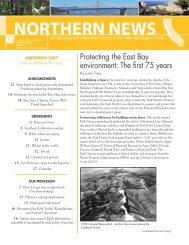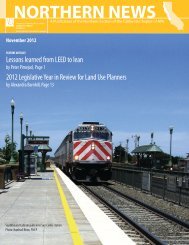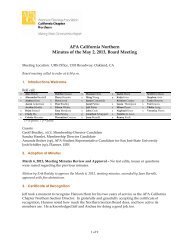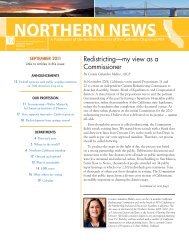Layout 1 - Northern California Chapter of the American Planning ...
Layout 1 - Northern California Chapter of the American Planning ...
Layout 1 - Northern California Chapter of the American Planning ...
Create successful ePaper yourself
Turn your PDF publications into a flip-book with our unique Google optimized e-Paper software.
On Language: How we speak and write 2Grammar gaffes will get youHBR Blog Network, March 12, 2013Bryan A. Garner, http://bit.ly/YXDtCX “People see yourlanguage as a reflection <strong>of</strong> your competence. Make lots <strong>of</strong>mistakes in your emails, reports, and o<strong>the</strong>r documents, andyou’ll come across as uneducated and uninformed.“Consider pronouns. Certain errors will predictably getyou in trouble: ‘Just keep this matter between you and I,’for instance, and ‘Tom and her will run <strong>the</strong> meeting.’ Writeinstead: ‘Just keep this matter between you and me.’ And:‘She and Tom will run <strong>the</strong> meeting.’“Subject-verb disagreement is ano<strong>the</strong>r common problemto watch out for: A verb must agree in person and numberwith its subject. But syntax can make things tricky. There isposes a problem because There appears to be <strong>the</strong> subject. It’snot. It’s what grammarians call an expletive — a word thatstands in for <strong>the</strong> subject in an inverted sentence. The truesubject follows <strong>the</strong> verb. So don’t write, ‘There is alwaysrisk and liability considerations.’ Use are — your subjectis considerations.“Were you told in school never to begin a sentence witha conjunction? So was I. But look at all <strong>the</strong> Ands and Butsthat begin sentences in high-quality prose. They’re everywhere.As sentence-starters, <strong>the</strong>se words keep readers goingsmoothly with <strong>the</strong> train <strong>of</strong> thought. They’re short, sharp, andfleet. They don’t break any real rules — and <strong>the</strong>y never have.Grammatically, <strong>the</strong>re’s nothing wrong with using Additionallyand However as sentence-starters. But stylistically, <strong>the</strong>y’reinferior. Multisyllabic connectors don’t join as cleanly andas tightly as monosyllables do.“It’s also perfectly acceptable to end a sentence with apreposition. Consider: What will <strong>the</strong> new product be used for?versus For what purpose will <strong>the</strong> new product be used?“Good style gets readers focused on your clear, concisemessage. Bad style draws attention to itself.” nBOOK REVIEWReshaping Metropolitan America: ... to 2030 (continued from page 7)• Denver, from 5 to 32 percent,• Kansas City, from 12 to 27 percent,• Seattle, from 11 to 31 percent,• Milwaukee, from 6 to 25 percent, and• Los Angeles, from 11 to 25 percent.Nelson <strong>of</strong>fers a comprehensive perspective on <strong>the</strong>difficulties <strong>of</strong> <strong>the</strong> housing crisis, mortgage foreclosures,energy costs, commuting times, owning vs. renting, highreal estate prices, and resident preferences.The author’s recommendations include:• Make accessory dwelling units legal,• Eliminate <strong>the</strong> social engineering in <strong>the</strong> federaltax code,• Change state property tax mechanisms,• Level <strong>the</strong> home purchase playing field,• Eliminate <strong>the</strong> economic inequities <strong>of</strong> localexclusionary zoning policies,• Use mortgage instruments that value benefits<strong>of</strong> higher densities and proximity to centers,• Instill fairer facilities financing, and• Instill local government discipline in permitting.Here is a quick rundown <strong>of</strong> contents:• The first chapter documents <strong>the</strong> past tradition<strong>of</strong> suburban growth and <strong>the</strong> “<strong>American</strong> Dream”<strong>of</strong> home ownership.• <strong>Chapter</strong> 2 describes <strong>the</strong> growing market — andhousing preference trends — for more compact developmentpatterns now and over <strong>the</strong> next two decades.• The third chapter covers demographic changes(such as smaller family and household sizes).• <strong>Chapter</strong> 4 supports <strong>the</strong> view that all new developmentshould be infill and redevelopment to satisfy publicdemand.• The fifth chapter describes how all development needscan be met without fur<strong>the</strong>r suburbanization or spreadinginto <strong>the</strong> exurbs and rural landscape.• <strong>Chapter</strong> 6 covers <strong>the</strong> social, economic, and physicalbenefits <strong>of</strong> higher density development through infilland renewal, versus continuing <strong>the</strong> past urban andrural sprawl.• The final chapter <strong>of</strong>fers Nelson’s agenda to reshape<strong>the</strong> United States over <strong>the</strong> next 20 years to providea more efficient, attractive, and healthy environment.Dr. Donald Bradley, AICP, is <strong>the</strong> AICPDirector for <strong>Nor<strong>the</strong>rn</strong> Section.You can reachhim at dr.donbradley@comcast.netReshaping Metropolitan America: DevelopmentTrends and Opportunities to 2030.Dr. Arthur C. Nelson, FAICP, Pr<strong>of</strong>essor <strong>of</strong> City &Metropolitan <strong>Planning</strong>, University <strong>of</strong> Utah (IslandPress, 2013). Paperback, $35. 168 pages.ISBN: 9781610910330 n<strong>Nor<strong>the</strong>rn</strong> News 16 May 2013





![[NAME OF EVENT] EVALUATION FORM](https://img.yumpu.com/32351925/1/190x245/name-of-event-evaluation-form.jpg?quality=85)

